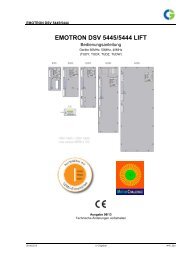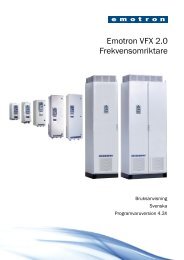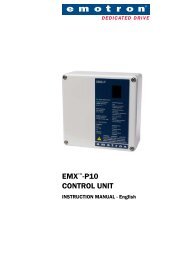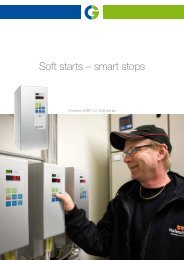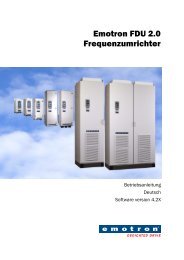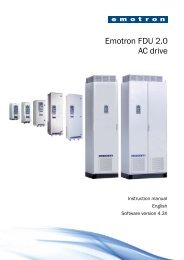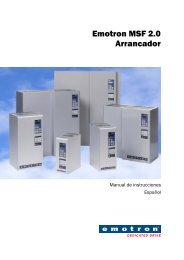DIETZ GSV 544X-xxx/400 Current Converter For Brush ... - Emotron
DIETZ GSV 544X-xxx/400 Current Converter For Brush ... - Emotron
DIETZ GSV 544X-xxx/400 Current Converter For Brush ... - Emotron
Create successful ePaper yourself
Turn your PDF publications into a flip-book with our unique Google optimized e-Paper software.
<strong>DIETZ</strong> <strong>GSV</strong> <strong>544X</strong>-<strong>xxx</strong>/<strong>400</strong><br />
<strong>DIETZ</strong> <strong>GSV</strong> <strong>544X</strong>-<strong>xxx</strong>/<strong>400</strong><br />
<strong>Current</strong> <strong>Converter</strong> <strong>For</strong> <strong>Brush</strong>-Type<br />
DC Motors<br />
Attachment<br />
Operating Instructions<br />
<strong>DIETZ</strong> DSV 5444, DSV 5445 Lift<br />
Edition 04/07<br />
Subject to technical modifications<br />
(Interim)<br />
12.04.07 © <strong>Emotron</strong> AB g444_04e.doc
<strong>DIETZ</strong> <strong>GSV</strong> <strong>544X</strong>-<strong>xxx</strong>/<strong>400</strong><br />
Dear customer / user,<br />
System DSV 5445 - Lift offers you a high-quality, modern and very powerful drive concept for old<br />
and new lift and lifting gear systems.<br />
The field oriented system DSV 5445 - Lift can power all common winch types (both with and without<br />
gearing and independent of synchronous or asynchronous technology).<br />
The customer/user should read these instructions carefully and should have understood them before<br />
starting work.<br />
The following products:<br />
<strong>GSV</strong> <strong>544X</strong> ; DSV 5445 ; DSV 5452 ; DSV 5453 ; DSV 5445/5453-Plus-series<br />
KD 915 , KD 920 ; Fine HF-SET 93251340268 (DSV 5452 incl. movable cubicle) ;<br />
Brake resistors 4...40 Ohm (Type Cressall, Frizlen, Danotherm),<br />
comply with the following directives and standards:<br />
Low voltages directive 73/23/EWG - amendment 93/68/EWG - EMC directive 89/336/EWG, amendments<br />
92/31/EWG and 93/68/EWG, incl. actually EMC directive 2004/108/EG<br />
including the appropriate amendment directives up to date of drawing.<br />
The following standards are used:<br />
EN 60204-1 1998-11 IEC 61000-3-2: 2002-12 EN 55011: 1998<br />
EN 61800-3 pr A.1.1 1999 IEC 61000-3-2/A1: 1997 EN 55011/A1: 1999<br />
EN 61800-3 pr A11 ; 1999 IEC 61000-3-2/A2: 1998 EN 55011/A2: 2000<br />
EN 61800-3 2002-04 EN 61800-2 1999-08 EN 61800-4 2003-08<br />
EN 12015 2004 EN 12016-08 1998 VDE 0660 Part 500 (IEC 439, EN 60439)<br />
EN 61800-6-3 2002-08 EN 55011B (basic emission standards) incl. IEC801 Part 1-5<br />
VDE 0875 Part 11 2003-08 EN 61000-6-3/AA 2004-07 EN 61800-1 1999-08<br />
Optional on request : EN 954-1 part EN 61508 (not for all products available).<br />
The declaration covers the modules and units delivered by us, but the user must ensure that the machine<br />
complies with the directives applicable to the end product after mounting or installation.<br />
Following the IEEE915 directive line reactors of 4% uk minimum are needed, further information or special<br />
solutions will be projected and quotated on request.<br />
<strong>Emotron</strong> Lift Center GmbH<br />
Max-Planck-Straße 15<br />
D 72639 Neuffen<br />
Telefon: ++49 (0)7025/101-0<br />
Telefax: ++ 49 (0)7025/5824<br />
eMail: info@emotron.com<br />
http://www.emotron.com<br />
(alt) eMail: info@Dietz-electronic.de<br />
(alt) http://www.Dietz-electronic.de<br />
Seite 2 © <strong>Emotron</strong> AB 12.04.07
DIGITAL DC-DRIVE <strong>GSV</strong> <strong>544X</strong>-<strong>xxx</strong>/<strong>400</strong><br />
List of contents<br />
1 Introduction 5<br />
2 Safety Notice 6<br />
3 Technical data 7<br />
3.1 Type code <strong>GSV</strong> 544x: 7<br />
3.2 Electrical data 7<br />
3.2.1 Power connection and accessories 8<br />
4 Power connection 9<br />
4.1.1 Power connection armature circuit with drive contactors for lift applications 10<br />
5 Parameter overview 11<br />
5.1 Operating instruction <strong>GSV</strong> <strong>544X</strong>-<strong>xxx</strong>/<strong>400</strong> 11<br />
5.1.1 WinDietz 1.19 hints 11<br />
5.2 Software package 11<br />
5.2.1 Standard application <strong>GSV</strong>.KOM 11<br />
5.2.2 Lift DC standard <strong>GSV</strong>50MHZ.KOM 11<br />
5.2.3 Shelf access equipment conveyor technique <strong>GSV</strong>NIKE.KOM / <strong>GSV</strong>RBG.KOM / <strong>GSV</strong>DIG.KOM 11<br />
5.3 Description of inverter equipment options 11<br />
5.4 Overview parameters and variables standard 12<br />
5.5 Overview parameters and variables lift 15<br />
5.6 Explanations of parameters 18<br />
5.6.1 "F0" armature excitation 18<br />
5.6.2 t rotor time constant 18<br />
5.6.3 First initialisation flag 18<br />
5.6.4 Commutating limit parameters F1, F2 and variables 0E6A, 0E6E 19<br />
6 TIPS, TRICKS 20<br />
7 Hotline note 22<br />
8 Technical data for enquiry order 23<br />
12.04.07 © <strong>Emotron</strong> AB Seite 3
<strong>DIETZ</strong> <strong>GSV</strong> <strong>544X</strong>-<strong>xxx</strong>/<strong>400</strong><br />
Explanations of terms:<br />
Nominal device current<br />
The current that is available at the device output, taking the operating<br />
time into account.<br />
Dynamic output current<br />
The current that is available at the device output for approx. 60 seconds.<br />
Declaration normally in %.<br />
Maximum rotational speed n max Maximum rotational speed at nominal current, as stated on motor rating<br />
plate.<br />
Nominal rotational speed n N Rotational speed at maximum current, as stated on motor rating plate.<br />
Field excitation<br />
Field current, field voltage; as stated on motor rating plate, can be set<br />
with parameters.<br />
Armature nominal voltage<br />
Nominal voltage of armature at nominal excitation and nominal rotational<br />
speed. Range for supply voltage <strong>400</strong>V 3AC: <strong>400</strong>-460 V DC<br />
Armature excitation Preset value actually "25"<br />
Rotor time constant Motor parameter that determines the motor torque<br />
(between 25...250 ms, ex works preset to 100 ms.<br />
P Brake<br />
Continuous power of the braking resistor<br />
Load capacity<br />
Permitted payload of the lift car in kg.<br />
v max<br />
Maximum speed of the lift car in metres per second.<br />
η Gear Efficiency of the employed gear (value smaller than 1)<br />
Characteristic factor Specific value for the employed motor, actually: "700"<br />
Lifting height<br />
Maximum height of the lift hoist way<br />
Start delay<br />
Specifies the time in seconds between opening the brakes and start of<br />
travel.<br />
Braking delay<br />
Specifies the time in seconds before the brake closes.<br />
OFF delay<br />
Time for motor demagnetisation before motor contactors are open.<br />
Stopping distance EH<br />
Distance that the lift car travels after reaching the level signal.<br />
Braking ramp B<br />
Characteristic of braking gradient.<br />
Run-up ramp HL<br />
Characteristic of run-up gradient.<br />
Starting jerk<br />
Caused by static friction or mechanical "adhesion" during starting.<br />
suspension<br />
Determined by the number of guide pulleys in the lift hoist way.<br />
Translation ratio<br />
Gear reduction number.<br />
Number of gear ratios<br />
Gear reduction number.<br />
E.g. Declaration on gear 56 : 2 → reduction 56, → number of gear<br />
ratios 2<br />
1 Vpp – encoder type High quality encoder whose output signal has a sinusoidal profile with<br />
a peak-to-peak value of 1 volt. (4 tracks)<br />
TTL encoder type<br />
Encoder of average quality with transistor-transistor logic, i.e. output<br />
signal has a rectangular shape and supply voltage is usually 5 V DC.<br />
(4 tracks)<br />
HTL encoder type<br />
Encoder of inferior quality with high-transistor logic, i.e. output signal<br />
has a rectangular shape, but supply voltage is up to 30 V DC. (2<br />
tracks, cannot be monitored)<br />
Tracks<br />
Number of encoder signals that are displace by 90 ° to each other.<br />
Seite 4 © <strong>Emotron</strong> AB 12.04.07
<strong>DIETZ</strong> <strong>GSV</strong> <strong>544X</strong>-<strong>xxx</strong>/<strong>400</strong><br />
1 Introduction<br />
Inverter for brush-type DC motor with IGBT-inverter technology:<br />
♦ Speed-, position-, torque control without dead times of a thyristor controller.<br />
♦ Armature- and field current control (2,5 - 12 kHz) PWM avoids alternating torques.<br />
♦ Special pulse-width modulation method (2,5 -12 kHz) for «whisper-silent running», no speed<br />
dependent noise.<br />
♦ Conservation of motor winding without additional choke by dv/dt limitation, therefore also suitable<br />
for converting existing systems.<br />
♦ High efficiency ≥ 97% at 65% duty cycle (
<strong>DIETZ</strong> <strong>GSV</strong> <strong>544X</strong>-<strong>xxx</strong>/<strong>400</strong><br />
2 Safety Notice<br />
• The installation, commissioning and parameter configuration may be performed only by qualified<br />
personnel, who have thoroughly read and understood these commissioning instructions.<br />
• The technical documents and program versions issued by the manufacturer must always be<br />
used for commissioning.<br />
• The unauthorised removal of parts of the enclosure, improper use and incorrect installation or<br />
operation can cause fatal or serious injury and material damage.<br />
• Set before first initialisation or reconnection the first initialisation -flag (E60)<br />
• The inverter DC-DRIVE <strong>GSV</strong> 5444-<strong>xxx</strong>/<strong>400</strong> is only for operating DC drives. Other electrical<br />
consumers are prohibited! Otherwise there will be danger of live and material damage.<br />
• Commissioning, i.e. the commencement of operation for the intended purpose, is permitted<br />
only subject to the applicable EMC directives.<br />
• Oil lubrication in a power or force transmission systems with an oil-filled gear casing (geared<br />
motor) or reduction gears can deteriorate during operation at low speeds. Information on the<br />
permissible continuous speed range must be obtained from the gear manufacturer.<br />
• Armature-, field current and encoder have to be the same sense of rotation.<br />
• If reactive power compensation equipment is installed in the power mains, it is to be checked<br />
for correct function.<br />
• If earth-leakage relays are employed, their sensitivity should be 300 mA or more per converter.<br />
The earth-leakage relays must be suitable for pulsed DC currents.<br />
• Check the required motor current at all speeds after completing commissioning (current measurement<br />
or evaluation of terminal A6).<br />
• This short manual is only in conjunction with the corresponding operating instructions<br />
for three phase drives valid. There you can find also how to operate this drive and the<br />
pin assignment of the input/output clamps.<br />
Seite 6 © <strong>Emotron</strong> AB 12.04.07
<strong>DIETZ</strong> <strong>GSV</strong> <strong>544X</strong>-<strong>xxx</strong>/<strong>400</strong><br />
3 Technical data<br />
3.1 Type code <strong>GSV</strong> 544x:<br />
<strong>GSV</strong> <strong>544X</strong> - 40 / <strong>400</strong><br />
Nominal supply voltage [V]<br />
Nominal device current [A]<br />
-4 <strong>GSV</strong> normal; -5 <strong>GSV</strong> lift<br />
Type key<br />
3.2 Electrical data<br />
♦ Typical input voltage range: 3 × <strong>400</strong>V ±10 % TT-, TN-system<br />
(3 x 500V .+5%/-15%) TT-, TN-system (option)<br />
(1/3 x 230V ±10 % ) TT-, TN-system (option)<br />
Other connection voltages and/or IT system on<br />
request<br />
♦ Power mains frequency: 50...60 Hz ± 5 %<br />
♦ Control voltage for fans from 80A-DSV: 230V +5, -15 %<br />
♦ Control voltage PLC level: +24V ±15 %<br />
♦ Typical power factor: >0,97<br />
♦ Armature voltage:<br />
0...460 V at Un 3AC <strong>400</strong> V<br />
♦ Field voltage:<br />
0...460 V at Un 3AC <strong>400</strong>V<br />
♦ Field current:<br />
0...10 A (option 0-25A) controlled<br />
♦ Pulse frequency adjustable:<br />
2,5...12 kHz<br />
♦ Typical du/dt:<br />
< 1 kV/µs (with AddOn - filter)<br />
♦ Dynamic output current (I dyn ): 150 % (200% size 1 10A)<br />
♦ Duty cycle:<br />
100 % at 2,5 kHz PWM<br />
65 % (50%) at 10 kHz (12 kHz) PWM<br />
♦ Control range (encoder 1Vpp): 1:32000<br />
♦ Field suppression mode: 100...200%<br />
♦ Default set point:<br />
digital, analog SPS, bus<br />
♦ Fixed speeds Lift 7TZ: 6<br />
♦ Speed thresholds: 3<br />
♦ Protection class: IP 20<br />
♦ Ambient temperature: 0 ... 40 °C<br />
Power decrease from 40 °C at 1,5 % per 1 °C (maximum up to 55 °C)<br />
♦ Storage temperature: -20 ...70 °C<br />
♦ Humidity rating E to DIN <strong>400</strong>40<br />
♦ Installation altitude up to 1000m, thereafter power reduction 6% per 1000m<br />
12.04.07 © <strong>Emotron</strong> AB Seite 7
<strong>DIETZ</strong> <strong>GSV</strong> <strong>544X</strong>-<strong>xxx</strong>/<strong>400</strong><br />
3.2.1 Power connection and accessories<br />
<strong>GSV</strong> 5444<br />
I dyn [A]<br />
Output<br />
power<br />
[kW]<br />
Powerloss<br />
[kW<br />
Rec.<br />
motor type<br />
power<br />
[kW]<br />
Networkfuse<br />
RFI motor<br />
filter<br />
Addon<br />
10 20 4,6 0,19 3,0-5,0 3 × 16 AT Size. 1<br />
20 30 9,2 0,41 6,5-11 3 × 25AT Size. 2<br />
30 45 13,8 0,58 9,0-15,0 3 × 50 AT Size. 3/0<br />
40 60 18,4 0,75 15,5-21,5 3 × 63 AT Size. 3/1<br />
60 90 27,6 1,2 22,0-29,5 3 × 80 AT Size. 3/3<br />
80 120 36,8 1,5 30,0-44,5 3 × 125 AT Size. 4/2<br />
120 180 55,2 2,25 45,0-65,0 3 × 160 AT Size. 4/3<br />
150 225 69,0 3,0 55,0-75,0 3 × 200 AT Size. 5<br />
200 300 92,0 4,0 65,0-110,0 3 × 250 AT Size. 5<br />
250 375 115,0 5,0 90,0-132,0 3 × 250 AT Size. 5<br />
Motor type [KW]<br />
Network fuse<br />
Line reactors<br />
Conductor crosssection<br />
Field current<br />
Brake resistor<br />
Line reactors<br />
3 × 1,5 mH<br />
(16A)<br />
3 × 0,7 mH<br />
(35A)<br />
3 × 0,7 mH<br />
(35A)<br />
3 × 0,5 mH<br />
(50A)<br />
3 × 0,3 mH<br />
(80A)<br />
3 × 0,25 mH<br />
(100A)<br />
3 × 0,18 mH<br />
(130A)<br />
3 × 0,12 mH<br />
(200A)<br />
3 × 0,12 mH<br />
(200A)<br />
3 × 0,10 mH<br />
(250A)<br />
Conductor<br />
cross-section<br />
mains/motor<br />
lines<br />
1,5 mm² *<br />
2,5 mm² *<br />
4,0 mm² *<br />
6,0 mm² *<br />
10 mm² *<br />
25 mm² *<br />
35 mm² *<br />
50 mm² *<br />
70 mm² *<br />
70 mm² *<br />
Brake resistor<br />
cable crosssection<br />
41 Ω / 450 W<br />
2. x.1,5 mm²<br />
41 Ω / 1 kW<br />
2. x.1,5 mm²<br />
18,8 Ω / 2 kW<br />
2. x.2,5 mm²<br />
18,8 Ω / 2 kW<br />
2. x.2,5 mm²<br />
14,4 Ω / 4 kW<br />
2. x.2,5 mm²<br />
14,4 Ω / 4 kW<br />
2. x.2,5 mm²<br />
13 Ω / 6,5 kW<br />
2. x.4,0 mm²<br />
10 Ω / 6,5 kW<br />
2. x.4,0 mm²<br />
6,5 Ω / 11 kW<br />
2. x.4,0 mm²<br />
6,5 Ω / 11 kW<br />
2. x.4,0 mm²<br />
The above mentioned data are suitable for armature nominal voltage of 460V<br />
DC.<br />
The type "gL" can be used for the network fuse. In case of using semiconductor<br />
fuses the nominal current has to be increased.<br />
Depending on the operating time, mechanical and electrical specifications of the<br />
system the nominal data of the line reactor can drift.<br />
The given cross-sections are standard values regardless the ambient conditions,<br />
used cable types and network fuses. Because of this the cross-sections can vary<br />
depending on the applicable regulations.<br />
0 - 10 A 1,5 mm² 0-20 A 2,5 mm²<br />
The dimensioning of the brake resistor has to be verified by means of the lift data!<br />
Seite 8 © <strong>Emotron</strong> AB 12.04.07
<strong>DIETZ</strong> <strong>GSV</strong> <strong>544X</strong>-<strong>xxx</strong>/<strong>400</strong><br />
4 Power connection<br />
Driving via interface only if required.<br />
Bridge the clamps 23 and 24 if thermistor is connected to external controller.<br />
Connect varistor to brake magnet.<br />
12.04.07 © <strong>Emotron</strong> AB Seite 9
<strong>DIETZ</strong> <strong>GSV</strong> <strong>544X</strong>-<strong>xxx</strong>/<strong>400</strong><br />
4.1.1 Power connection armature circuit with drive contactors for lift applications<br />
The modern IGBT-based drive technology combined with old DC machines provides an excellent ride quality<br />
at maximum efficiency.<br />
But a few things need to be taken into account if you want the system to operate with the usual reliability for<br />
many years to come. Especially the often very low armature voltage and the electric strength of all windings<br />
against earth must be taken into consideration. There are only a few products able to stand the intermediate<br />
circuit voltage or high du/dt of modern inverters.<br />
When the armature voltage is distinctly below 300V, an isolating transformer is usually required upstream of<br />
the inverter which also assures the electric strength against earth.<br />
High-quality-contactors need to be provided in the armature circuit which in emergencies (i.e. high DC current<br />
and high DC voltage) can interrupt the supply of energy to the armature circuit. But the contactors no longer<br />
need to be dimensioned to provide a steadily recurring isolation under load. The power varistor of the DC<br />
motor armature is a particularly important component as it prevents the collector from being damaged when<br />
the safety circuit is opened. Depending on the performance of the motor, the varistor has a tablet size between<br />
40 and 80 and a voltage matching the effective intermediate circuit. An inverter with a 3AC 230V network<br />
therefore requires a 300V varistor at the armature winding (e.g. type SIOV B60K300).<br />
<br />
There must be no contactor in the field circuit. There are only two contactors in the armature<br />
circuit, the three pairs of contacts of which are each connected in series in the below example.<br />
Non-binding switching proposal for the power circuit (R3 = 2kΩ 0,5W carbon film):<br />
Seite 10 © <strong>Emotron</strong> AB 12.04.07
<strong>DIETZ</strong> <strong>GSV</strong> <strong>544X</strong>-<strong>xxx</strong>/<strong>400</strong><br />
5 Parameter overview<br />
5.1 Operating instruction <strong>GSV</strong> <strong>544X</strong>-<strong>xxx</strong>/<strong>400</strong><br />
This manual needs as a completion the basic operating instruction of Vectordrive DSV 5444 resp. Multidrive<br />
DSV 5445 Lift. There you can find handling, programming and so on described in detail.<br />
5.1.1 WinDietz 1.19 hints<br />
WinDietz hints in detail you can find in the corresponding manual.<br />
Select the inverter type in the WinDietz start window: DSV 5444/ML for standard- or DSV5445/MLL for lift<br />
applications.<br />
5.2 Software package<br />
5.2.1 Standard application <strong>GSV</strong>.KOM<br />
The software package 1 <strong>GSV</strong>.KOM with the menu prompt <strong>GSV</strong>_D.CNF (German) resp. <strong>GSV</strong>_E.CNF (English)<br />
are suitable for standard application with analog and/or digital default set point.<br />
5.2.2 Lift DC standard <strong>GSV</strong>50MHZ.KOM<br />
The software package 2 <strong>GSV</strong>50MHZ.KOM with the menu prompt LIFT<strong>GSV</strong>E.CNF is a lift program for operating<br />
high- and low speed DC winches with or without gear.<br />
5.2.3 Shelf access equipment conveyor technique <strong>GSV</strong>NIKE.KOM / <strong>GSV</strong>RBG.KOM /<br />
<strong>GSV</strong>DIG.KOM<br />
The software package 3 <strong>GSV</strong>NIKE.KOM / <strong>GSV</strong>RBG.KOM / <strong>GSV</strong>DIG.KOM with the menu prompt<br />
<strong>GSV</strong>NIKE.CNF / <strong>GSV</strong>RBG.CNF / <strong>GSV</strong>DIG.CNF) for the system <strong>GSV</strong> 5444-<strong>xxx</strong>/<strong>400</strong> is for modernisation projected.<br />
A short-term description is available on request.<br />
5.3 Description of inverter equipment options<br />
The <strong>GSV</strong> series is a precision drive for armature- and field voltages up to max. 460 Volt DC nominal voltage.<br />
The system is high dynamic and stiff in control. Integrated SPS- function, current-, speed- and position control<br />
are as standard.<br />
The <strong>GSV</strong> 5444 has its connectors at the front "X1" to "X4".<br />
The <strong>GSV</strong> 5445 has its connectors sideways "X1" to "X4".<br />
As standard both inverters were with brake chopper and field current control equipped. Furthermore is for<br />
protection of the motor winding and for radio interference suppression the AddOn-Filter attached. Additional<br />
smoothing chokes in the armature circuit are not necessary and should be removed in case of modernisation.<br />
Both in the armature- and in the field current circuit a high dynamic current control avoids alternating torques.<br />
Up to the double nominal speed is the field suppression mode possible, unless this high speed is released<br />
from the motor manufacturer. The standstill torque can be utilised, accordingly to the motor specification, up<br />
to the maximum output current of the inverter.<br />
The actual speed value will be retrieved, contrary to former times, through modern incremental encoders,<br />
whereas we recommend sin/cos 1Vpp encoders with 1024 resp. 2048 increments per motor revolution.<br />
Thereby a speed set point range 1:32000 can be reached. Encoder- and armature voltage refeeding are not<br />
provided. Sources for rotary encoders you can find in the basic manual DSV 5445.<br />
<br />
The internal FU-Control is not able to encode all possible applications itself. Please check the<br />
menu item "operation mode", if the suitable application has been selected.<br />
Is the system e.g. operating with "<strong>GSV</strong>_NIKE" (shelf access equipment) and you are working<br />
with standard application "<strong>GSV</strong>.KOM", the operation mode has to be changed to "normal"<br />
before editing parameters or variables!<br />
12.04.07 © <strong>Emotron</strong> AB Seite 11
<strong>DIETZ</strong> <strong>GSV</strong> <strong>544X</strong>-<strong>xxx</strong>/<strong>400</strong><br />
5.4 Overview parameters and variables standard<br />
Factory settings for <strong>GSV</strong>.KOM (general engineering).<br />
Parameters and variables Adr. Remarks factorysettings<br />
armature excitation F0 Factory setting! Leave this value always on “25” for all DC motors. 25<br />
nominal speed F1 Default value is the speed n nom, that can be driven with I max as stated on<br />
motor rating plate.<br />
maximum speed F2 Default value is the maximum speed n max,, that can be driven with I nom as<br />
stated on motor rating plate.<br />
PCG, holding force position<br />
control loop<br />
F3 P-gain, holding force for position control. 40<br />
target ramp (F42 nd root section)<br />
position control loop<br />
1650<br />
1800<br />
F5 Maximum speed for 2 nd root braking curve range. 1250<br />
I-part position control loop F6 I-part of control position, the higher the value, the smoother the start up. 24<br />
P-part position control<br />
loop<br />
F7<br />
P-part of control position as high as possible until the motor is near humming;<br />
set P-values always before setting I values (standard 800)<br />
offset 1 for zero position F8 Offset for zero position for F11 (in the same direction of rotation) 0<br />
factor of analog set point<br />
value<br />
F9 Standardisation for analog set point value (operating mode B1) 730<br />
speed divisor F10 Speed divisor <strong>400</strong>2<br />
reduced speed.1 for positioning<br />
F11 Reduced positioning speed; positioning in the same direction as the machine<br />
is running.<br />
reference cycle speed F12 Speed of reference cycle. -150<br />
speed tolerance<br />
SET/ACTUAL on<br />
speed tolerance<br />
SET/ACTUAL scan on<br />
speed tolerance<br />
SET/ACTUAL off<br />
speed SET/ACTUAL scan<br />
off<br />
position tolerance<br />
SET/ACTUAL on<br />
position SET/ACTUAL scan<br />
on<br />
F13 Maximum speed deviation (tolerance window) for setting the “REQUIRED =<br />
ACTUAL” message.<br />
F14 F14*0,8 ms (scan time) gives the period, in which the speed must fall<br />
within the tolerance window to set the message “SET = ACTUAL”.<br />
F15 Minimum speed deviation (tolerance window) for deleting the "REQUIRED<br />
= ACTUAL" message.<br />
F16 F16*0,8 ms gives the period, in which the speed must fall outside the tolerance<br />
window to reset the message “SET = ACTUAL”.<br />
F17 Maximum position deviation (tolerance window) to set the message<br />
“REQUIRED = ACTUAL”.<br />
F18 F14*0,8 ms gives the period, in which the position must fall within the tolerance<br />
window to set the message “SET = ACTUAL”.<br />
800<br />
1500<br />
100<br />
10<br />
200<br />
5<br />
500<br />
10<br />
Seite 12 © <strong>Emotron</strong> AB 12.04.07
<strong>DIETZ</strong> <strong>GSV</strong> <strong>544X</strong>-<strong>xxx</strong>/<strong>400</strong><br />
Parameters and variables Adr. Remarks factorysettings<br />
position tolerance<br />
SET/ACTUAL off<br />
position SET/ACTUAL<br />
scan off<br />
insert factor<br />
F19 Minimum position deviation (tolerance window) for deleting the<br />
"REQUIRED=ACTUAL" message.<br />
F20 Value of F20*0,8 ms gives the period, in which the position must fall outside<br />
the tolerance window to reset the message "SET=ACTUAL".<br />
F21 Standardisation factor for position control commands ("C" "D" "H") and<br />
parameters F8 and F26.<br />
speed factor F22 Standardisation for specified standard set point (operating mode B0) /<br />
Standardisation for speed control commands ("O" ,"G") and parameters<br />
F11, F12 and F27.<br />
increment number factor F23 Increment number factor 256<br />
change-over of transducer<br />
transmission.<br />
RS485 address<br />
F24 Change-over of transducer transmission. 2<br />
F25 Sets the unit address if there are several units connected to one bus.<br />
F25=0 communication via bus operation is cut off .<br />
offset2 for zero position F26 Offset for zero position for F27 (in the positioning direction) 0<br />
reduced speed 2 for position<br />
jerk<br />
F27 Reduced positioning speed; direction of rotation reversed for reference<br />
travel.<br />
F28 Limitation of the maximum acceleration. The higher F28, the faster the set<br />
point value is sought.<br />
Inc. follower F29 Increment number ratio of follower drive 125<br />
Inc master drive<br />
F30 Increment number ratio of master drive (increment number of master drive<br />
in relation of follower drive speed). Only the speed value is evaluated.<br />
number of poles F31 Factory setting! Leave this value always on “2”. 2<br />
Intergr.zeitk. TIN-N I I-part for speed control. 12<br />
amplification VPN_N K P-part for speed control. 800<br />
rotor time constant t Factory setting! Leave this value always on “100” for all DC motors. 100<br />
run-up ramp Y0 The higher this value, the smoother and longer the acceleration. <strong>400</strong><br />
return ramp Y1 The higher this value, the smoother and longer the deceleration. 480<br />
automatic brake torque E4E Customised settings. 0<br />
Standardised analog speed E50 Customised settings. 0<br />
hyst. analog speed E52 Customised settings. 0<br />
offset analog speed E54 Customised settings. 0<br />
max. digital speed E56 Customised settings. 0<br />
Standardised analog torque E58 Customised settings. 0<br />
hyst. analog torque E5A Customised settings. 0<br />
offset analog torque E5C Customised settings. 0<br />
max. digital torque E5E Customised settings. 0<br />
2000<br />
5<br />
64<br />
13988<br />
5<br />
0<br />
1600<br />
125<br />
12.04.07 © <strong>Emotron</strong> AB Seite 13
<strong>DIETZ</strong> <strong>GSV</strong> <strong>544X</strong>-<strong>xxx</strong>/<strong>400</strong><br />
Parameters and variables Adr. Remarks factorysettings<br />
first initialisation flag<br />
E60 This flag is for monitoring the allocation field current, armature current and<br />
encoder sense of rotation. <strong>For</strong> protecting the motor please always set this<br />
flag! Only very dynamical drives cause a switch-off in case of error.<br />
mode digital/analog E62 Switching digital (0) / analog (255) default set point 0<br />
internal/external zero<br />
E64 Internal referencing (0) analysis of the zero track<br />
external (255) input INT2<br />
interface mode E66 Mode interface. 5<br />
SG18-LG18-flag E68 Select memory mode: event memory (0). error memory (255) 0<br />
set point field current<br />
E6A Set point field current; input as stated on motor rating plate, nominal<br />
field current in mA.<br />
encoder type 1Vpp/TTL E6C Select encoder type (1Vpp = 0; TTL=255) 0<br />
commutation limit<br />
E6C Between the revolutions n nom and n max the armature current will be decreased<br />
to the reduced value. ( % of I nom )<br />
255<br />
0<br />
1000<br />
80<br />
<br />
Encoder increments actually only 1024 increments per motor revolution preset<br />
Please change the bold values of the factory settings only after well examination resp. after<br />
calling back our company.<br />
Seite 14 © <strong>Emotron</strong> AB 12.04.07
<strong>DIETZ</strong> <strong>GSV</strong> <strong>544X</strong>-<strong>xxx</strong>/<strong>400</strong><br />
5.5 Overview parameters and variables lift<br />
Factory settings for <strong>GSV</strong>50MHZ.KOM (lift applications with or without gear, based on *7TZ.KOM/UPD).<br />
Adr Parameters and variables Remarks factorysettings<br />
F0 armature excitation Factory setting! Please don’t change value “25”! 25<br />
F1 Nnom (Imax) Default value is the speed n nom, that can be driven with I max as stated on<br />
motor rating plate.<br />
F2 Nmax (Inom) Default value is the maximum speed n max,, that can be driven with I nom as<br />
stated on motor rating plate.<br />
F3 P-part stop and hold P holding gain (position control) is the holding force at standstill that prevents<br />
reverse rotation up to closing the brake.<br />
F6 I-part start to end I-gain in the position controller; the larger the value, the softer the start<br />
transition.<br />
F7 P-part start to end P-gain in the position controller; as high as possible. Drive may however<br />
not "hum" during starting. The P-value should always be set before I-<br />
values. (standard 1200)<br />
F10 Standardisation of speed These parameters need not to be observed, if for the calculation of F10, 15715<br />
F21 Standardisation of distance<br />
F21, F23 the variable 0E48 is set to 255 (read only).<br />
320<br />
F22 Speed adjustage 27976<br />
F23 encoder factor setup<br />
F24 switch to F23-default Read only. 2<br />
F25 show firmware F25=0 0<br />
F26 stop distance to floor Stopping distance after level magnet/zone. 40<br />
F29 A0-old=242 A0-new=3862<br />
Function of output A0; “242” motor energised, “3862” activation of the motor<br />
contactors.<br />
F30 PWM-adjustment fine This value may not be changed without consultation with the factory. 500<br />
F31 number of poles Factory setting! Leave this value always on “4”. 4<br />
I I-part run I-part ; setting irrelevant see E1A and E1C 8<br />
K P-part speed run P-part of the speed control. 800<br />
t rotor-time constant The rotor time constant value range 25.....250 ms. 100<br />
B34 version of program Version of the command program (read only) 99<br />
E00 Vi inspection run Enter speed in m/s. 0,600<br />
E02 V3 fast stage Enter speed in m/s. 2,500<br />
E04 V2 intermediate stage Enter speed in m/s. 1,500<br />
E06 V1 low stage Enter speed in m/s. 1,000<br />
E08 Ve drive-in stage Enter speed in m/s. 0,050<br />
E0A Vn adjust stage Enter speed in m/s. 0,004<br />
170<br />
200<br />
12<br />
16<br />
800<br />
2048<br />
3862<br />
E0C Direction of rotation<br />
E12 Start clearance run<br />
E14 Open door at V lower<br />
<strong>For</strong> E0C = 0 ➔ 24 V level = UP and 0 V level = DOWN.<br />
<strong>For</strong> E0C = 255 ➔ 0 V level = UP and 24 V level = DOWN.<br />
If speed is less than the set value (m/s), then output A1 is set. At speeds<br />
less than the set value, the lift will stop at the next levelling pulse.<br />
If the speed is less than the set value (m/s), then output A2 is set.. At<br />
speeds less than the set value, following lift function is enabled: "Early<br />
opening doors".<br />
E16 excess speed Output A3 will be low at V x >E16 (start value = 1,15 * V3) 2,850<br />
0<br />
0,700<br />
0,300<br />
12.04.07 © <strong>Emotron</strong> AB Seite 15
<strong>DIETZ</strong> <strong>GSV</strong> <strong>544X</strong>-<strong>xxx</strong>/<strong>400</strong><br />
Adr Parameters and variables Remarks factorysettings<br />
E18 return ramp B The higher this value, the smoother and longer the stopping distance. 25<br />
E1A pointed arch Pointed arch will be activated E1A = "255". 0<br />
E1C I-part stop and hold<br />
I-part stop and hold avoids reverse motion when the brake is opening.<br />
Activated during standstill.<br />
E1E I-part run I-part run. replaces function of parameter I (I-part run normal)! 32<br />
E20 ramp gradient Standard value = 200 200<br />
E22 run-up ramp HL The higher this value, the smoother and longer the acceleration. 50<br />
E24 braking delay<br />
E26 OFF delay<br />
The time after stopping V = 0 m/s, the motor continues to be magnetised<br />
until the brake has closed mechanically.<br />
Delay time for signals A0 and A7 for motor demagnetisation before contactors<br />
are open.<br />
E28 start delay Time between the mechanical opening of the brake and start up. 250<br />
E3C Schmitt flag<br />
Brake opens when signal E0 is present, digital mode.<br />
In preparation: switching from digital to analog mode (0E3C = 0)<br />
E3E JP3 flag TTL Set encoder type (sinusoidal= 0, TTL= 255) 0<br />
E40 suspension Number of pulleys 1:1 o. 1:2........ 2<br />
E42 transmission Gear (10 ... 100) 1=gearless 1<br />
E44 number of cycles Gear steps 1=gearless 1<br />
E46 driving wheel diameter. Effective drive wheel diameter in 'mm'. 570<br />
E48 calculation? yes = 255, no = 0. calculation F10, F21 255<br />
E4A encoder increments Set encoder increments. 2048<br />
E4C starting jerk speed. Starting jerk speed to overcome the static friction during start 0,002<br />
E4E starting jerk time Time needed to overcome static friction. 250<br />
E50 Findili flag Simultaneous signal at V1 and V2 results V3. 0<br />
E52 N_IST_FILTER_ALLE<br />
E54 ISQ_IST_FILTER_ALLE<br />
The actual value of the encoder is filtered if: E52 = 0 without; 255 medium;<br />
256 high.<br />
If 0 is selected, the regulation is stiffer, but slight noise may occur, depending<br />
on the quality of the encoder signal.<br />
The torque output is filtered if: E52 = 0 without; 255 medium; 256 high.<br />
If 0 is selected, the regulation is stiffer, but heavy noise may occur,<br />
depending on the quality of the encoder signal.<br />
E56 64_256_FLAG 50 MHz Read only: shows the multiplication type. 255<br />
E58 no reset on error<br />
E5A value of iidt-timer<br />
E60 first initialisation flag<br />
<strong>For</strong> '0', the inverter is automatically reset after a fault.<br />
<strong>For</strong> '255', it waits with all current faults for a reset.<br />
Unacceptable high current, incorrect rotating fields and phase angle, and 5000<br />
loose encoder lead to a shut-down of the inverter after the time in E5A (I²dt<br />
error has occurred).<br />
This flag is for monitoring the allocation field current, armature current and<br />
encoder sense of rotation. <strong>For</strong> protecting the motor please always set this<br />
flag! Only very dynamical drives cause a switch-off in case of error.<br />
E62 emergency evacuation Corresponding to LIFT7TZ. 255<br />
E64 DCP=90,CAN=165,ACP=85 Selection of bus mode. 90<br />
E66 baud rate Selection of baud rate DCP, CAN, ACP 1<br />
E68 SG18-LG18-flag Event memory 0. fault memory 255 255<br />
8<br />
750<br />
125<br />
255<br />
255<br />
255<br />
23<br />
255<br />
Seite 16 © <strong>Emotron</strong> AB 12.04.07
<strong>DIETZ</strong> <strong>GSV</strong> <strong>544X</strong>-<strong>xxx</strong>/<strong>400</strong><br />
Adr Parameters and variables Remarks factorysettings<br />
E6A set point field current Input as stated on motor rating plate in mA, i.e. 1A = 1000mA 13500<br />
E6C stopping distance<br />
Stopping distance for direct approach after gear-down point in mm (read<br />
only)<br />
E6E commutation<br />
Between the revolutions n nom and n max the armature current will be decreased<br />
90<br />
to the reduced value. ( % of I nom )<br />
Please change the bold values of the factory settings only after well examination resp. after<br />
calling back our company.<br />
<br />
Detailed information about the parameters and variables you can find in the lift manual<br />
l445_21e.<br />
<strong>400</strong>0<br />
12.04.07 © <strong>Emotron</strong> AB Seite 17
<strong>DIETZ</strong> <strong>GSV</strong> <strong>544X</strong>-<strong>xxx</strong>/<strong>400</strong><br />
5.6 Explanations of parameters<br />
5.6.1 "F0" armature excitation<br />
The armature excitation "F0" is actually preset to "25" (valid for all DC motors).<br />
5.6.2 t rotor time constant<br />
The rotor time constant "t" is responsible for the torque (armature) of the motor. Too high values of<br />
"t" will effect losses regarding torque. Too small values will effect oscillation in the acceleration<br />
range. The rotor time constant for optimal control mode is between 25...250 ms. t increases normally<br />
proportional with the motor power, but will be preset to 100ms for all DC motors because the<br />
effect is not measurable.<br />
5.6.3 First initialisation flag<br />
The first initialisation flag switches on an effective monitoring to protect the DC motor from the<br />
"runaway". If unexpected errors occur when using very high dynamic drives, this monitoring can be<br />
switched off.<br />
Seite 18 © <strong>Emotron</strong> AB 12.04.07
<strong>DIETZ</strong> <strong>GSV</strong> <strong>544X</strong>-<strong>xxx</strong>/<strong>400</strong><br />
5.6.4 Commutating limit parameters F1, F2 and variables 0E6A, 0E6E<br />
Parameters “F1” and “F2” as well as variables “0E6A” and “0E6E” are new:<br />
”F1” (Nnom - Imax) is the speed up to which the operation is effected with full armature current. From “F1”<br />
onwards the armature current is limited by the commutating limit “0E6E” up to the “F2” speed.<br />
”F2” (Nmax - Inom) is the speed up to which the commutating limit “0E6E” is supposed to run. After “F2” the<br />
field suppressing is starting (the field being reduced to half as a maximum).<br />
”0E6A” (field current) indicates the field winding value in “mA”. The field as well as the armature currents are<br />
controlled so that the magnetic field does not depend on the temperature.<br />
”0E6E” (commutating limit) is indicated as a nominal current percentage. In between the “F1” and “F2”<br />
speeds the current is e.g. limited to 90% of the nominal current.<br />
Connection between the parameters F1, F2 and variable 0E6E<br />
Up to the “F1” speed the full DC inverter dynamics are put at disposal. From the “F1” speed up to the “F2”<br />
speed it is possible to limit the armature current in order to protect the commutator. Cell “0E6E” indicates the<br />
percentage (referred to the motor’s Imax rating plate) by which the current has to be reduced.<br />
From “F2” onwards, up to 2 x “F2” are linearly run into the field suppression. In this particular case it must<br />
however be taken into account that both functions are not always parallelly available. One can either select a<br />
field suppression or adjust the black band.<br />
Example 1 (black band as from 135 rpm up to the end-speed of 159 rpm):<br />
F1 = 135<br />
F2 = 159<br />
0E6E = 70%<br />
In example 1 the “F2” speed corresponds to the maximum operating speed of the machine (e.g. for 2,5m/s).<br />
Example 2 (field suppression as from 110 rpm up to e.g. 220 rpm with a 1 to 2 ratio):<br />
F1 = 109<br />
F2 = 110<br />
0E6E = 90%<br />
In example 2 the motor also has to run up to 159 rpm but with a field that is suppressed by a factor 1.34 (the<br />
field current must e.g. drop from 8A to 6A). With this setting the field current is reduced to 50% from “F1” =<br />
110 rpm up to 2 x “F2” = 220 rpm. <strong>For</strong> 159 rpm this results in 75%. On the other hand the value in “0E6E” has<br />
practically no effect since “F1” and “F2” inevitably are close.<br />
12.04.07 © <strong>Emotron</strong> AB Seite 19
<strong>DIETZ</strong> <strong>GSV</strong> <strong>544X</strong>-<strong>xxx</strong>/<strong>400</strong><br />
6 TIPS, TRICKS<br />
1) Motor reacts independently from the drive step with slow speed and draws a high current:<br />
<br />
When high current is drawn at a low speed, the A6 signal is present for several<br />
seconds. This state causes considerable overload of the motor and converter!<br />
Stop the run immediately and seek the fault.<br />
♦ Encoder damaged or is not running with the motor.<br />
♦ PPR number is not suitable (1024 1Vpp is standard -> check memory cell 0E4A)<br />
♦ Wrong allocation of the direction armature current-, field current, and/or encoder direction.<br />
2) Encoder error alarm or severely uneven running:<br />
♦ Cable wired incorrectly or encoder defective<br />
♦ TTL encoder instead of 1Vpp fitted (check memory cell 0E3E)<br />
♦ Coupling is defective or encoder screen is not connected at both ends<br />
♦ Pin 12 in connector X3 must have contact to protective earth at DSV<br />
3) No confirmation signal from signal "A0" (controller ON):<br />
♦ One of the enable signals "ISP" or "E0" not present, check wiring<br />
♦ "E0" was not removed after end of run, measure signal<br />
4) Direct approach does not function, since signal "Ve" removed in levelling zone:<br />
♦ INT is self-generated via output „A5", i.e. you have to check the cable connection between<br />
input INT and output A5.<br />
5) Motor cannot bear the load (pull it out of the catch) or stalls:<br />
♦ Check the motor terminal plate (check armature- and field current)<br />
♦ Incorrect dimensioning of a drive device (efficiency of the system "Pay attention to machine<br />
top/bottom")<br />
♦ Measure if field and/or armature current is correct.<br />
6) Motor buzzes at standstill or hums loudly at low speeds:<br />
♦ Gain values to high<br />
♦ Reduce P-gain stop, start and run<br />
♦ Encoder not located at the position with the largest mass inertia<br />
♦ Encoder coupling or encoder mounting is not applicable.<br />
7) Driving wheel jerks backwards noticeably during start:<br />
♦ I-part run and start not low enough<br />
♦ P-part stop too low<br />
8) Drive jerks during start (starting jerk):<br />
♦ Soft start time too short, run-up rounding too steep<br />
♦ Soft speed not matched to static frictional (too high)<br />
♦ With epicyclical gears: Increase I-gain run and P-gain stop<br />
♦ With old worm gears: Select high I-gain run and small P-gain stop<br />
Seite 20 © <strong>Emotron</strong> AB 12.04.07
<strong>DIETZ</strong> <strong>GSV</strong> <strong>544X</strong>-<strong>xxx</strong>/<strong>400</strong><br />
9) Noticeable transition from "Ve" interrupt during stopping:<br />
♦ "Ve" not matched to the "approach distance", solution by reduction of "Ve" or increase distance<br />
in parameter "F26".<br />
♦ The gear-down point to the approach speed "Ve" is located too close to the level position.<br />
This causes an excessively steep approach from the interrupt point. Remedy: Move the<br />
gear-down point further back until a crawl speed is reached up to the interrupt point. Now increase<br />
the return rounding so that the transition is made without a noticeable crawl distance.<br />
10) External 24 V supply voltage is short-circuited as soon as an input is activated or connected<br />
at DSV<br />
♦ The 24 V level was exceeded by more than 25 %.<br />
♦ The DSV protection elements have responded.<br />
♦ Please send the device to our factory for examination<br />
11) Lift travels at half or double speed<br />
♦ Check values for number of gears and suspension.<br />
12) Output A9 not removed in levelling zone.<br />
If parameter F7 (P-gain start) is too large, A9 will sometimes not be removed; if k (P-gain run) is<br />
too large, run will be terminated prematurely. Too large results in the motor humming, see also<br />
Point 6) Motor …<br />
13) Phase fault message during emergency evacuation<br />
♦ E1 for …7SZ.* or flag 0E62h for …9SZ.* not activated.<br />
14) At start up switched off with fault message “armature or field voltage?”<br />
♦ Field not connected or polarity wrong.<br />
15) Only at high speed the inverter switches off with fault message “armature or field voltage?”<br />
♦ Field voltage higher than 2:1<br />
♦ Mains voltage too low.<br />
<br />
If the difference between the set point and actual values of the speeds is not too<br />
high at high speeds, the first initialisation flag 0E60 can also be set to “0”. In this<br />
case the above mentioned monitoring is disabled.<br />
12.04.07 © <strong>Emotron</strong> AB Seite 21
<strong>DIETZ</strong> <strong>GSV</strong> <strong>544X</strong>-<strong>xxx</strong>/<strong>400</strong><br />
7 Hotline note<br />
<br />
Please check the following points before calling our<br />
hotline:<br />
Tel. +49-7025-101-29 / -42<br />
Fax: +49-7025-5824<br />
www. emotron.com<br />
(old) e-mail: info@dietz-electronic.de<br />
We require several pieces of information to be able to help you with problem cases. Please complete the<br />
form and give us the data. (by telephone or by fax.)<br />
Customer and order information<br />
Customer address<br />
Date:<br />
Contact person:<br />
Tel.(on-site):<br />
Order:<br />
Fax:<br />
Frequency converter data<br />
<strong>GSV</strong>544... A / V<br />
M-number:<br />
Lift data<br />
Installed program:<br />
Controller manufacturer:<br />
Load capacity: kg Total height: m<br />
Cabin empty weight: kg Largest floor height: m<br />
Max. travelling speed V3 m/s Smallest floor height: m<br />
Motor data Armature nominal voltage: V<br />
Manufacturer: Nominal current: A Maximum current: A<br />
Motor number: Field nominal voltage: V<br />
Power: Field nominal current: A<br />
nnom: 1/min nmax: 1/min<br />
Gear data Worm gear? yes no<br />
Manufacturer: Gear number: Epicyclical gear? yes no<br />
Translation ratio: Belt drive? yes no<br />
Suspension: Efficiency: % Number of pulleys:<br />
Drive wheel diameter: Gear position: bottom top<br />
Fault/problem occurs:<br />
at switch-on<br />
during start<br />
during acceleration<br />
during constant<br />
travel<br />
during deceleration<br />
when stopping<br />
in both directions<br />
only during travel UP<br />
only during travel<br />
DOWN<br />
in flush area<br />
Fault is reproducible<br />
Fault occurs sporadically<br />
Short description of fault:<br />
Seite 22 © <strong>Emotron</strong> AB 12.04.07
<strong>DIETZ</strong> <strong>GSV</strong> <strong>544X</strong>-<strong>xxx</strong>/<strong>400</strong><br />
8 Technical data for enquiry order<br />
If ordering equipment please always complete this form and mail or fax it to:<br />
<strong>Emotron</strong> Lift Center GmbH, Max-Planck-Straße 15, D-72639 Neuffen<br />
Fax: +49-7025-5824, Tel. +49-7025-101-0<br />
Customer and order information<br />
Date:<br />
Customer address<br />
Order:<br />
Contact person:<br />
Department:<br />
Tel.:<br />
Fax:<br />
Customer number<br />
Lift data Intermediate speed (V2): m/s<br />
Load capacity: kg Single-flor run (V1): m/s<br />
Cabin empty weight: kg Smallest floor height: m<br />
Maximum travelling speed (V3) m/s Largest floor height: m<br />
Motor data Armature nominal voltage: V<br />
Manufacturer: Nominal current: A Maximum <strong>Current</strong>: A<br />
Motor number: Field nominal voltage: V<br />
Power: Field nominal current: A<br />
nnom: 1/min nmax: 1/min<br />
Encoder type: 1Vpp TTL HTL smaller; increments: . . . . . . . . . . . . . . .<br />
(Recommended encoder type: 1Vpp sine/cosine-tracks with 1024 increments and supply voltage of 5 V DC).<br />
<strong>For</strong>ced ventil. ja: V, -phase; no, internal fan<br />
Gear data Worm gear? yes no<br />
Manufacturer: Epicyclical gear? yes no<br />
Gear number: Belt drive? yes no<br />
Suspension: Gearless? yes no<br />
Translation ratio: to number of gears: Effective drive wheel diameter: . . . . . . . . mm<br />
Gear position (location relative to lift shaft): bottom top Efficiency [%]: . . . . Number of pulleys: . . . .<br />
DC-Drive <strong>GSV</strong> 5444<br />
<strong>GSV</strong> 5444 LIFT for external brake resistor<br />
Energy recovery<br />
Emergency evacuation with battery 240 V DC<br />
Brake resistor<br />
present: Ω, W 100% ED; not present, please deliver<br />
AddOn-filter and line reactor<br />
present<br />
AddOn-filter desired<br />
not present, please deliver<br />
12.04.07 © <strong>Emotron</strong> AB Seite 23



